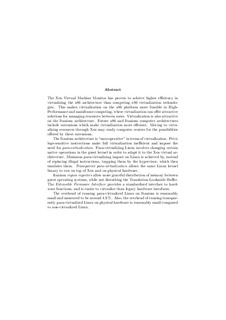HPC Virtualization with Xen on Itanium
Abstract
The Xen Virtual Machine Monitor has proven to achieve higher efficiency in virtualizing the x86 architecture than competing x86 virtualization technologies. This makes virtualization on the x86 platform more feasible in High-Performance and mainframe computing, where virtualization can offer attractive solutions for managing resources between users. Virtualization is also attractive on the Itanium architecture. Future x86 and Itanium computer architectures include extensions which make virtualization more efficient. Moving to virtualizing resources through Xen may ready computer centers for the possibilities offered by these extensions. The Itanium architecture is ``uncooperative'' in terms of virtualization. Privilege-sensitive instructions make full virtualization inefficient and impose the need for para-virtualization. Para-virtualizing Linux involves changing certain native operations in the guest kernel in order to adapt it to the Xen virtual architecture. Minimum para-virtualizing impact on Linux is achieved by, instead of replacing illegal instructions, trapping them by the hypervisor, which then emulates them. Transparent para-virtualization allows the same Linux kernel binary to run on top of Xen and on physical hardware. Itanium region registers allow more graceful distribution of memory between guest operating systems, while not disturbing the Translation Lookaside Buffer. The Extensible Firmware Interface provides a standardized interface to hardware functions, and is easier to virtualize than legacy hardware interfaces. The overhead of running para-virtualized Linux on Itanium is reasonably small and measured to be around 4.9 %. Also, the overhead of running transparently para-virtualized Linux on physical hardware is reasonably small compared to non-virtualized Linux.
